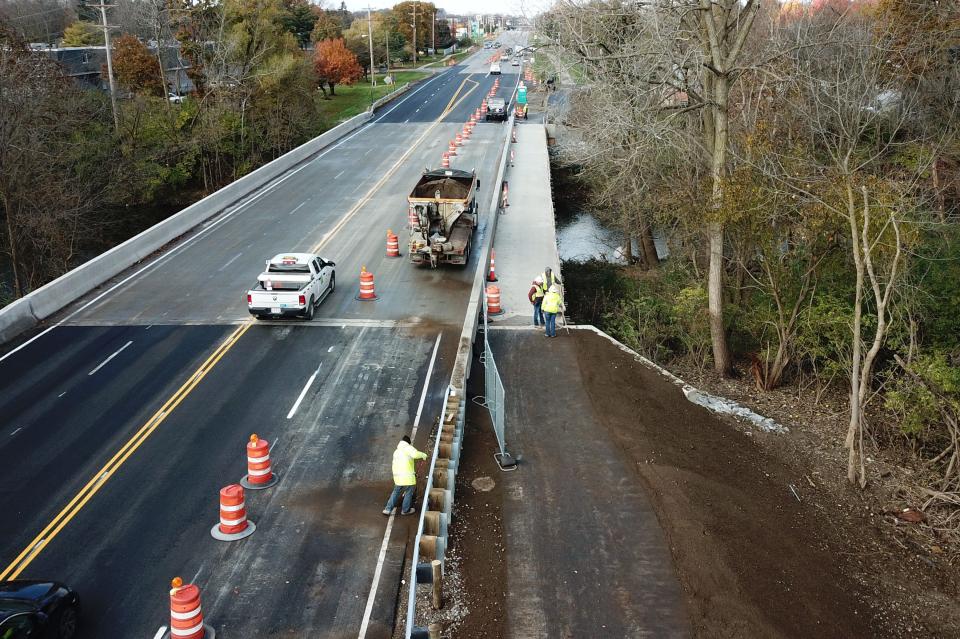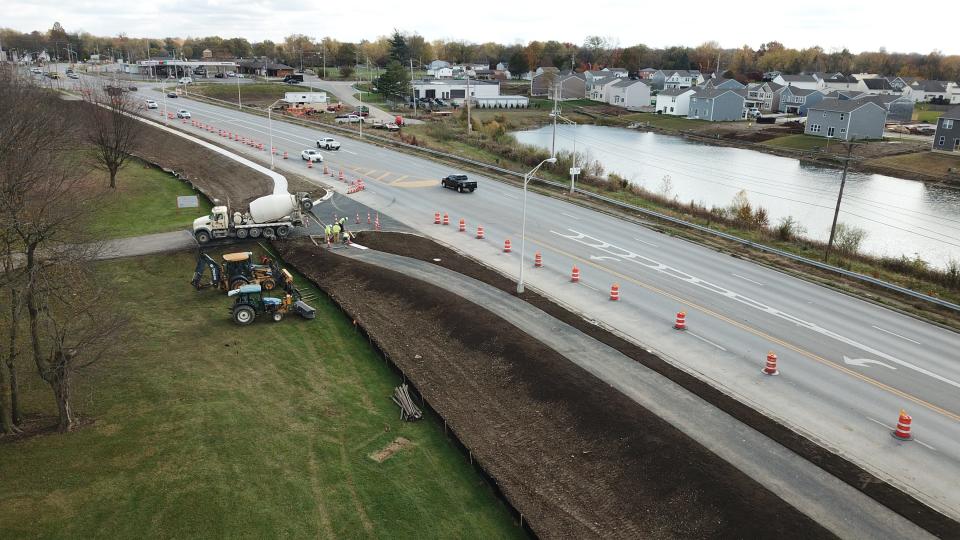Refugee Road bridge path part of Franklin County engineer's efforts to address disparities
It was a bridge sidewalk to nowhere, a pitiful pathway over Big Walnut Creek, connecting a rabbit trail on one side to a gap before an actual paved walkway on the other side.
Anyone trying to walk to Nafzger Park to the east or to a bus stop to the west or anywhere else in the vicinity of Refugee Road and the Eastland area on the Southeast Side did so at their own peril.
“Before, there was just the edge of the road and some gravel berm and then weeds,” said Franklin County Engineer Cornell Robertson, standing near the four-lane bridge over Big Walnut, within eyesight of the intersection of Refugee and Noe Bixby roads.

But not anymore. Just before Thanksgiving, a new, wide, multi-use path — stretching along the north side of Refugee Road from near Noe Bixby all the way to a residential area west of Big Walnut Creek — opened to pedestrians, joggers, wheelchair users and bicyclists.
Beyond a standard infrastructure update, it’s the latest project by the Franklin County Engineer’s Office to address disparities in the community.
“It’s been said by many folks that mobility is the great equalizer,” Robertson said. “I agree with that statement. It all zeros back to public health, safety and welfare, which is our primary responsibility as a government agency. Folks need to be able to access schools, they need to be able to access the grocery stores, they need to be able to get to doctors offices and hospitals.”
More: Franklin County engineer launching antiracism initiative
The Refugee Road bridge was one of 10 projects listed in the engineer’s Antiracism & Equity Program, an effort started in June 2020 that denounced “racism in all forms” and sought to ensure equity in contracting and other operations.
Robertson, the lone Republican holding a nonjudicial, elected office in Franklin County, was supportive of the county health department and board of commissioners resolutions earlier in 2020 declaring racism a public health crisis. The engineer’s office made its own statement with the Antiracism & Equity Program, looking “to take action against the complex nature of racism in the United States in a very intentional and purposeful manner.”

Some of the policies included in the program were directly aimed at addressing racism in the workplace, including zero tolerance for employees who use racial slurs, and annual diversity training. Simone Burley, diversity inclusion coordinator in the engineer's office, said employees in November were finishing the latest rounds of the latter as part of this year’s training.
The engineer's office also adopted a local school, Ohio Avenue Elementary in the Olde Towne East neighborhood near Downtown. About a dozen employees visit the school every other week to provide mentoring and tutoring, Burley said.
In addition, the engineer’s office started an equitable business enterprise program to ensure greater involvement of minority and underrepresented workers and firms in road and bridge projects. The office also increased its employee recruitment at historically Black colleges and universities and other minority organizations.
And then there’s roads and bridges. The Antiracism & Equity Program includes a focus on “first mile/last mile” improvements throughout Franklin County. That, Robertson said, means providing better access to public transportation, retailers, schools, medical and other services, particularly in underserved areas.
The program lists 10 separate projects as a starting point.

There’s the addition of a shared-use path and trail connector at Agler Road over Alum Creek, part of a $4.2 million improvement plan set to start in February.
There’s $10 million to $14 million in improvements to the northbound and southbound lanes of Alum Creek Drive over Big Walnut Creek, with construction potentially starting in 2026-27.
The list goes on from there: Cassady Avenue from Interstate 670 to Agler Road, Cleveland Avenue from Huy to Elmore roads, Cooke Road from I-71 to Cleveland Avenue.
In fact, most projects being considered by the engineer’s office nowadays include increased discussion of pedestrian pathways and other ways to improve access and mobility for residents.
“We’ve changed our philosophy,” said Ed Herrick, bridge design engineer. “We take a step back and say, 'What else do we need to do out here?'
"We don’t just do something to the bridge anymore, because anytime you do bridge work, we have to take the opportunity to say what’s going to happen in the next 75 years. We have to accommodate the development that’s going to take place 50 years from now," he said.

The Refugee Road bridge over Big Walnut Creek was built in 1968 and had a deteriorating metal sidewalk on the north side. The $2.6 million rehabilitation project, a collaborative effort of the Franklin County Engineer’s Office and the city of Columbus, included the widening of the bridge to accommodate a 10-foot shared use path, plus about 2,000 feet of additional path to the east and west of the bridge.
The project won’t be fully completed until next year, with installation of new railing, seeding and other finishing work. But the multi-use path opened to pedestrian traffic just before Thanksgiving, providing a safer route for area residents.
"It will improve safety," said Anthony Riffe, chair of the Greater South East Area Commission. "I imagine anyone walking through there is walking along Refugee Road, and Refugee Road is extremely busy. From a safety standpoint, it will be a big improvement for the area's residents."
The need for the improvements was evident throughout the project, Robertson said.
“There are neighborhoods to the west of the bridge, (and) there are many neighborhoods in all quadrants of the intersection of Refugee, Chatterton and Noe Bixby roads,” he said. “I was out here during construction. Every time I visited the projects, there were still pedestrians crossing the bridge, even during construction.”
mkovac@dispatch.com
@OhioCapitalBlog
This article originally appeared on The Columbus Dispatch: Columbus construction: Refugee Road bridge pathway opens

